I just finished reading The Perfect Horse: The Daring U.S. Mission to Rescue the Priceless Stallions Kidnapped by the Nazis by Elizabeth Letts. Not only was this rescue a humanitarian act involving saving horses with a pedigree and lineage dating back hundreds of years but this rescue was also one bright moment in the war where Hitler’s master race idea (in this case purebred horses) was foiled. The Nazis proved what they were capable of doing to achieve a master race—be it of people or animals. Some of the action takes place at Hostau, a Nazi-run stud farm in (then called) Czechoslovakia. This book is not just about the Lipizzaner rescue from Hostau, but the fate of these horses after the war. The book is a page turner – that’s for sure. It holds the reader’s interest with solid writing, suspense, good use of details, and a feeling of “we can do this, boys, so let’s get out there and save those horses!”
The Lipizzaner Horse or the Lipizzan, as it is known, is a horse meant for royalty. This horse was bred for the use of the Hapsburg royal family. The Lipizzaner horse is sometimes referred to as the white dancing horse. Its name is derived from Lipica or Lipizza, a village in Slovenia. This was where a stud farm was established by Archduke Charles II to breed this horse.
An interesting fact about this horse is that it is not white when it is born. As it molts, its color changes. The white coat that makes this horse so famous comes only after it turns seven years old.
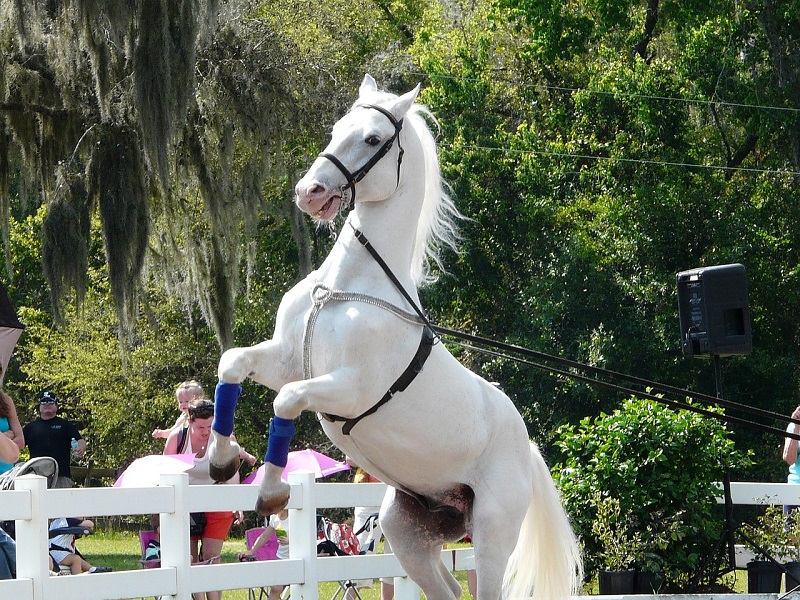
Image by Sylvia Blimes
It takes place in the chaotic last days of the war. A small troop of battle-weary American soldiers capture a German spy and makes an astonishing find—his briefcase is empty but for photos of beautiful white horses that have been stolen and kept on a secret farm behind enemy lines.
Adolf Hitler’s chief of breeding Gustav Rau was given a base in the Czechoslovakian town of Hostau to gather Europe’s finest horses from the Lipizzaners through to Arabs and other top thoroughbreds with a view to creating the perfect military horse.
Below is a short (less than 2 min) Nazi propaganda color film about the training of the beautiful Lipizzaner horses from 1944 with the original soundtrack.
Rau’s inspiration originated at the 1912 Olympics where some of the world’s best military horses were lined up next to each other, giving him the idea to “develop a German breed of military horse that was as clearly associated with Germany as the thoroughbred was with England”.
Perhaps this is why Hitler stockpiled the world’s finest purebreds on Hostoun, in order to breed the perfect military machine—an equine master race. But with the starving Russian army closing in, the animals were in imminent danger of being slaughtered for food.
Tucked into rolling hills and endless meadows of what was then Sudetenland, the town of Hostoun, Czech Republic, is about as far off the beaten track as you can get.
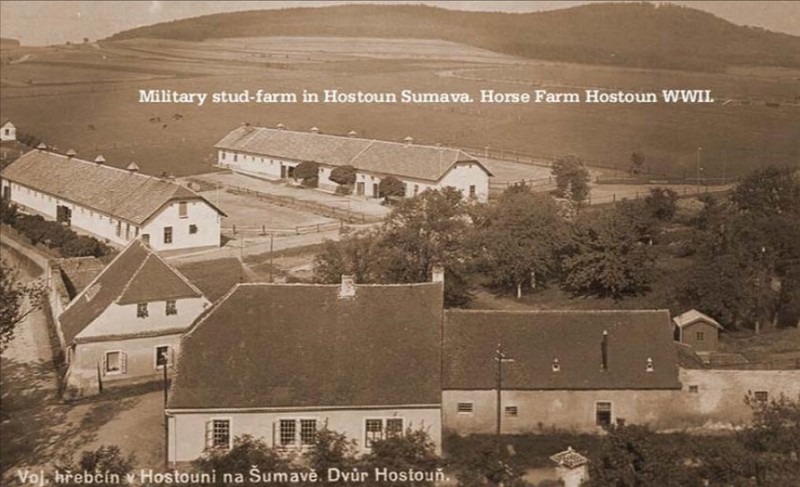
The German veterinarians at the farm, commanded by Lieutenant Colonel Hubert Rudofsky, had reason to be terrified about what the Russians could do to their horses because they already knew that during the liberation of Hungary, they had killed the whole Royal Hungarian Lipizzaner collection.
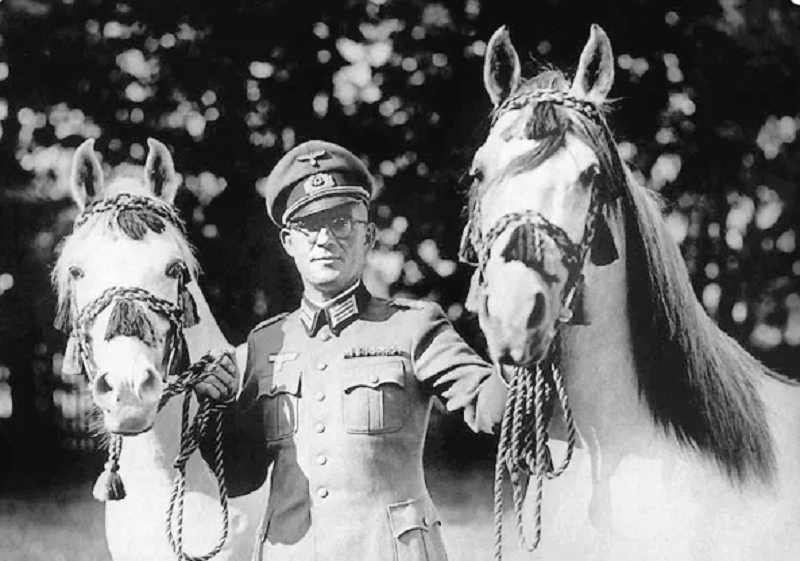
Hubert Rudofsky holds the reins of two purebred horses at Hostau.
With only hours to spare, one of the U.S. Army’s last great cavalrymen, Colonel Hank Reed, makes a bold decision—with General George Patton’s blessing—to mount a covert rescue operation.
We were so tired of death and destruction. We wanted to do something beautiful. – Col. Charles Hancock Reed
That’s correct…
US General Patton launched ‘Operation Cowboy‘ at Hostau, Czechoslovakia, rescuing a total of 1,200 horses, including 375 of the Lipizzan breed, from potential Soviet slaughter.
Operation Cowboy was fought in the Czechoslovakian village of Hostau, (now Hostouň, Czech Republic), on April 28, 1945, in the last days of the European Theater of World War II.
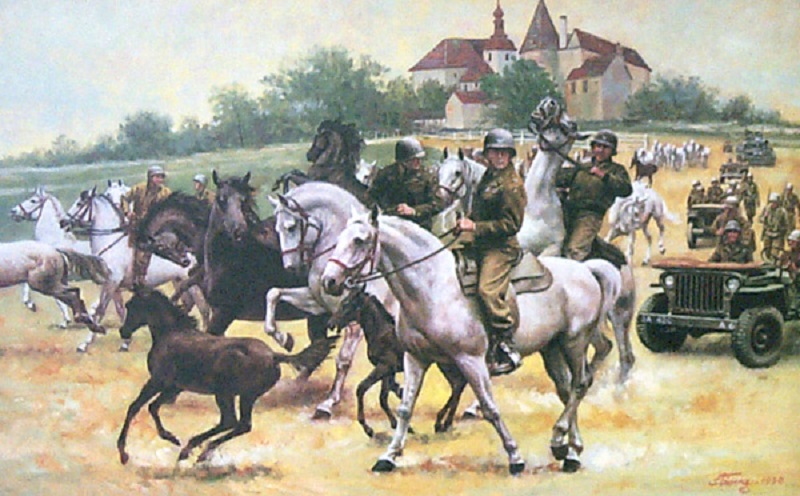
It is one of two known times during the war in which Americans and Germans of the Wehrmacht fought side by side against the Waffen-SS, the other being the Battle of Castle Itter.
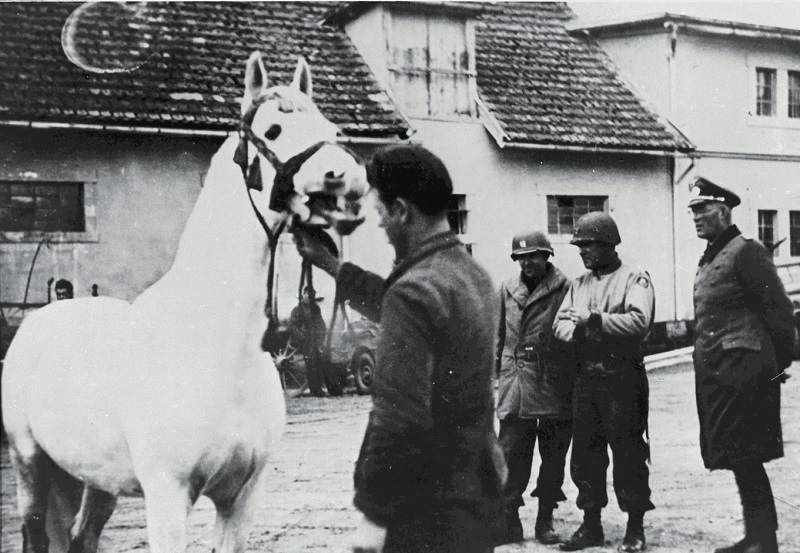
Captain Thomas M. Stewart (center) inspects a stallion at a stud farm the Germans had controlled in Hostau, Czechoslovakia. Stewart, an intelligence officer, was instrumental in getting the horses back in Allied hands—and protecting them from advancing Soviet troops.
US soldiers began riding, trucking, and herding the horses into Germany at Kotztinz.
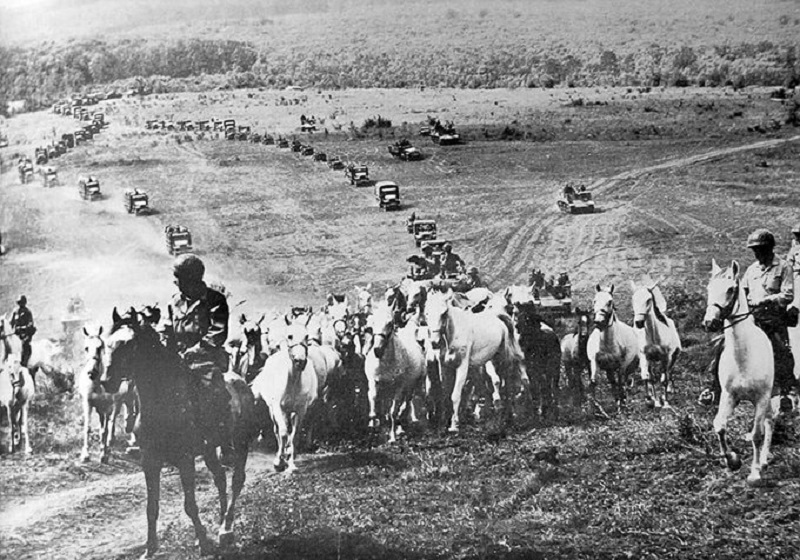
Racing against time, Reed’s small but determined force of soldiers, aided by several turncoat Germans, steals across enemy lines in a last-ditch effort to save the horses.
Below are two short documentary videos about the rescue…
Operation Cowboy, Triumph of Equestrianism Documentary. Triumph and Tragedy documentary on Operation Cowboy, the secret US and Nazi Mission to save the Lipizzaner in the last days of World War II. (10 minutes)
Operation Cowboy and the 1945 Rescue of Europe’s Stolen Horses. As the war in Europe drew to a close, a group of Americans undertook a daring raid to protect Europe’s legendary horses including the famous Lipizzaners. This is original content based on research by The History Guy. (14 minutes)
Pulling together this multi-stranded story, Elizabeth Letts introduces us to an unforgettable cast of characters: Alois Podhajsky, director of the famed Spanish Riding School of Vienna, a former Olympic medalist who is forced to flee the bomb-ravaged Austrian capital with his entire stable in tow; Gustav Rau, Hitler’s imperious chief of horse breeding, a proponent of eugenics who dreams of genetically engineering the perfect warhorse for Germany; and Tom Stewart, a senator’s son who makes a daring moonlight ride on a white stallion to secure the farm’s surrender.
During World War II, worried for the safety of the school and the horses due to bombing raids on Vienna, Podhajsky evacuated most of the stallions out of the city to Sankt Martin im Innkreis in Upper Austria. A number of mares from the Piber Federal Stud, the breeding farm that supplied horses for the school, were also evacuated.
Though the horses were in relative safety, there were still harsh challenges; there was little food for humans or animals, and starving refugees sometimes attempted to steal the horses, viewing them as a source of meat. As American General George Patton was leading his troops through Austria, he was alerted to the presence of the Lipizzans in Sankt Martin im Mühlkreis.
Patton and Podhajsky had each competed in equestrian events at the Olympic Games. The two men renewed their acquaintance, and after Podhajsky orchestrated an impressive performance by the remaining horses and riders of the school in front of Patton (a lifelong horseman) and Undersecretary of War Robert P. Patterson, the Americans agreed to place the stallions under the protection of the United States for the duration of the war.
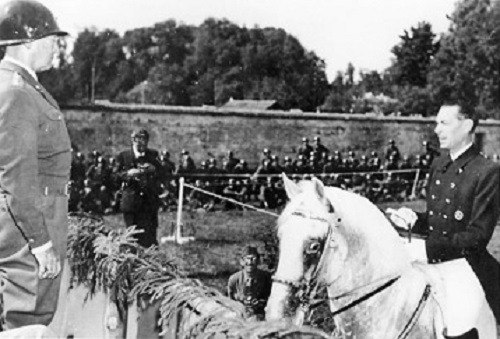
Gen. Patton & Col. Podhajsky after the evacuation of the Lipizzaners.
Podhajsky later wrote about these events, an account which was made into a motion picture Miracle of the White Stallions by Walt Disney Studios, with actor Robert Taylor playing Colonel Podhajsky.
Podhajsky alerted Patton to the location of additional Lipizzaner bloodstock. Many Lipizzaner mares and some stallions had been appropriated by the Germans from the Austrian breeding farm at Piber and sent to Hostau, to a Nazi-run stud farm in Czechoslovakia (now the Czech Republic).
These are drab materialistic times. Drab! Surely, if we can let into them one beam of elegance, of splendor, of glory, from the ancient classical world… that would be worth a man’s life. – Alois Podhajsky
When Hostau fell behind Soviet lines, captured German officers, under interrogation by U.S. Army Captain Ferdinand Sperl, provided details on the Lipizzaner’s location and asked the Americans to rescue the horses before they fell into Soviet hands because it was feared they would be slaughtered for horsemeat.
General Patton issued orders, and on April 28, 1945, Colonel Charles H. Reed, with members of Troops A, C, and F of the 2nd Cavalry Regiment, conducted a raid behind Soviet lines, accepted the surrender of the Germans at Hostau, and evacuated the horses.
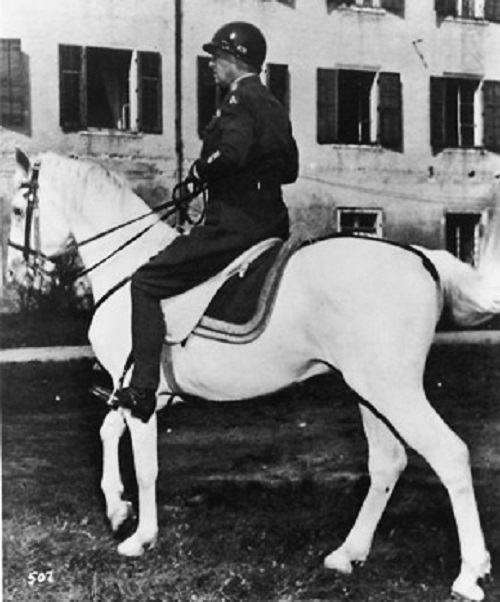
General Patton riding Lipizzaner Favory.
The Lipizzaners were relocated to Wels, then to Wimsbach, Upper Austria. Podhajsky is remembered most for saving the Lipizzaner breed, preserving their history following the war, as well as for his dedication to the advancement of classical dressage, and his contributions to the Spanish Riding School.
After the communists took over Czechoslovakia, the rescue of the Lipizzaners faded from memory. The Hostoun stud farm ceased to exist. It was turned into cow barns, and the locals were not allowed to mention horses. Only a few horses remained in stables in the nearby village of Svrzno, once part of the complex.
Miroslav Koza, a truck driver and horse fan, bought the stables in 1991 and turned them back into a working horse farm. But he knew nothing about the Lipizzaners.
Apparently, this author writes, “In 1994, an old man stopped at the stables and asked Koza’s daughter, Michaela Kodadov, who now runs the place, to show him around. “It still gives me chills,” she recalled recently. “He kept saying how happy he was that there were horses here again.” There were tears in his eyes. I had no idea who he was… It was Rudolf Lessing.
(Two German Army veterinarians, Captains Rudolph Lessing and Wolfgang Kroll, managed the irreplaceable herd of breeding and performance horses in Hostau. Lessing was the one who persuaded Reed to ‘capture’ Hostau. It was Lessing who crossed into Bavaria at night and found the Americans!)
Colonel Reed agreed to allow Captain Stewart to accompany Captain Lessing to Hostau, hoping to negotiate a peaceful surrender with the Germans, as well as obtain the release and evacuation of the POWs who were caring for the herds. On the evening of 26 April, beneath a full moon, Captains Stewart and Lessing crossed the CzechGerman border on horseback. Captain Stewart had ridden horses in his native Tennessee prior to the war and managed to keep up with Captain Lessing in their ride across the countryside, including jumping obstacles on the journey. After a short night’s sleep, Captains Stewart and Lessing were able to negotiate the peaceful surrender of Hostau, despite Lieutenant Colonel Rudolfsky’s initial intent to fight the advancing Americans. On the evening of April 27th, Captain Lessing accompanied Captain Stewart to the American lines.
Task Force Reed, commanded by Major Robert P. Andrews, was formed from the 42nd Squadron, 2nd Cavalry Group, and consisted of infantry, tanks, and assault guns to facilitate Operation Cowboy. Task Force Reed crossed the Czech-German border on the morning of April 28th. Most of the German troops surrendered without a fight, however, a group of Schutzstaffel (SS) troops posted near Hostau refused to surrender and challenged Task Force Reed. Miraculously, the Americans suffered only 2 seriously wounded casualties, Sergeant Owen Sutton and Private Raymond Manz. Both died from their wounds soon afterward. Private Manz was awarded the Distinguished Service Cross posthumously. The significance of this operation and their sacrifice was memorialized on September 16, 2006, when the Czech citizens of Bela nad Radbuzou, a small town near Hostau, erected monuments to Sergeant Sutton and Private Manz in memory of their heroic acts during the operation.
Much of the book takes place in Czechoslovakia, but Lipizzaner’s ties to Czech/Slovaks doesn’t end there…
Slovak Veterinarian at Tempel Farms
In the late 1950s, Tempel and Esther Smith attended a performance of the Spanish Riding School in Vienna. They were incredibly impressed with these beautiful animals and started a venture that would change their lives forever. A man of great vision, Tempel Smith not only felt that he should bring these horses to the United States but also that he should start a school of riding modeled after the Spanish Riding School. Not only were these horses extremely rare in the US, but the art of classical riding, or dressage, was virtually unheard of. In 1958 the Smiths imported twenty horses, mostly pregnant mares, to Spring Grove, IL. Over the next ten years, the Smiths recruited the help of many professional breeders, veterinarians, and riders to grow their herd and to maintain the quality of the herd and the riding.
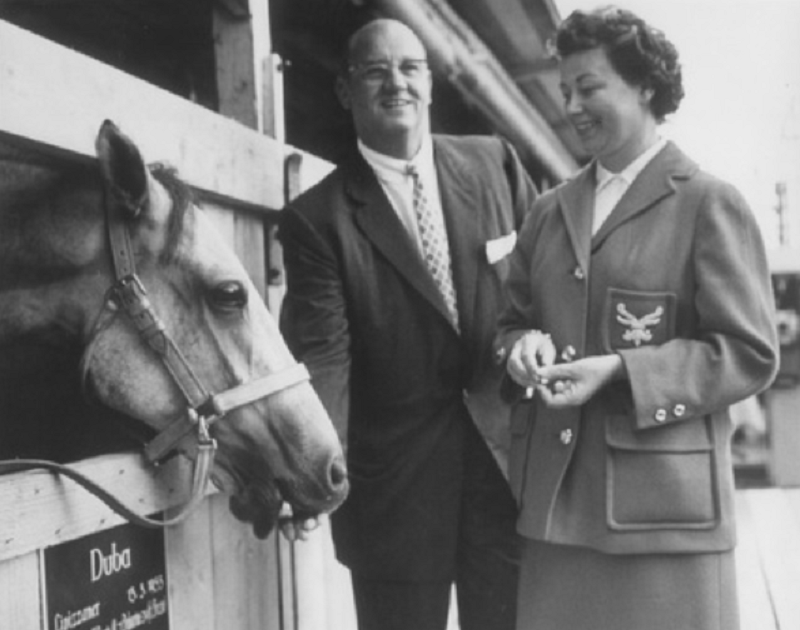
Tempel and Esther Smith greet their new Lipizzans in New York City with a cube of sugar.
Undoubtedly the health, well-being, and prosperity of these horses at Tempel Farms are due to the expert veterinary care by Dr. Ferjenčík.
Mikuláš Ferjenčík & the Lipizzaners in the United States
Slovak-born Dr. Mikulas Ferjenick bred these horses and was a veterinarian to the Lipizzaner horses at Tempel Farms for many years. He lived on-site and he and his wife Milada would occasionally invite members of the Czechoslovak National Council of America (of which he was chairman) to watch Lipizzaner performances and attend picnics at the farm.
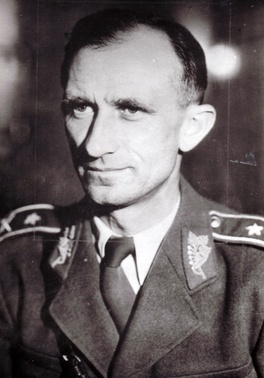
Mikuláš Ferjenčík
Mikuláš Ferjenčík (5. 12. 1904, Polomka – 4. 3. 1988, Littleton, USA) graduated from town school in Polomka. In the years 1915 – 1923 he studied at the Real Gymnasium in Rožňava and in the years 1923 – 1928 at the Veterinary College in Brno. On June 16, 1928, he was ceremoniously graduated and was awarded the academic title MVDr.
As a rookie on April 14, 1926, he was taken to the Czechoslovak Republic, destined for the 4th squadron of Cavalry Regiment 6 in Brno. As a soldier in 1928, he was presented on to perform military attendance service in Cavalry Regiment 6 in Brno and was shortly detached to the School for the Education of Reserve Veterinarian Officers at the Military Riding School (“VJU”) in Pardubice.
After graduating from school with very good grades, he was transferred as a veterinarian to Cavalry Regiment 10 in Berehovo in Subcarpathian Russia in April of 1929. For a short time, he worked as deputy chief veterinarian in Artillery Regiment 112 in Mukachevo.
From mid-May 1930 to mid-September 1934, he held the position of veterinarian of Cavalry Regiment 10, again in Berehova and on April 2, 1933, he was promoted to captain.
On September 15, 1934, he was transferred to VJU in Pardubice and appointed to the position of deputy chief veterinarian and professor of hippology in VJU schools and courses. He remained in this position until March 21, 1939, when, as a Slovak national, he was released from active military service in the Protectorate after the breakup of Czechoslovakia.
During his time in Pardubice, he actively participated in horse races in Prague at Chuchli, Poděbrady, Pardubice, and Karlovy Vary. He received achieved several important awards.
During the general mobilization of the Czechoslovak Armed Forces, (September 30 – October 30, 1938) he served as head of the veterinary service of the 13th division “Úprka” with headquarters in Humpolec. At the same time, for this transitional period, he was included in the regular number of the dragoon regiment 8 “Prince Wenceslas” in Pardubice in his mobilization assignment.
After the creation of the Slovak State, on March 21, 1939, he was transferred to the status of the Slovak Armed Forces, and on May 5 he was appointed head of the veterinary service of the HVV in Bratislava.
On May 17, 1939, he was promoted, this time to Major, and was assigned to the “Bernolák” Command, where, as head of the veterinary service, he participated in the campaign of the Slovak field army against Poland. On September 30, 1940, he was transferred from the MNO in Bratislava to the VPV in Banská Bystrica and appointed head of the veterinary administration of the VPV.
After the invasion of the USSR by Nazi Germany in June of 1941, as an officer assigned to the Army Headquarters, he took part in the campaign of the Slovak army on the Eastern Front from 6/27/1941 to 9/4/1941 and was promoted to Lieutenant Colonel where he was once again appointed to the position of head of the VPV veterinary administration in Banská Bystrica.
In May 1942, he established contact with the illegal civil resistance group Dr. Vavra Šrobár. As a close associate of Lt. Col. Gst. J. Goliana at the Military Headquarters, he participated in the preparations of the SNP. His role primarily consisted of preparing an illegal network and representing Lt. Col. Gst. Goliana in political issues. He was a member of the delegation of the illegal SNR, which flew to Moscow on August 4, 1944, with the aim of informing about the preparations for the armed Uprising in Slovakia and coordinating the SNP project itself with the operational plans of the Soviet Red Army.
After the mission in the USSR, M. Ferjenčík returned to Slovakia on September 4, 1944. He was appointed SNR commissioner for national defense and at the same time appointed to the position of head of the veterinary administration of the Headquarters of the 1st Czechoslovak Army. At the same time, he was also a member of the Council for the Defense of Slovakia, a body for combat coordination, operations, and unified command of the insurgent fight.
He had strong reservations about the validity of the existence of the Council, especially after many partisan units refused to submit to the command of the rebel army. On October 1, 1944, he was promoted to Colonel. After the partial suppression of the SNP, he went into the mountains, where he worked in the Czechoslovak Republic with the “Prvosienka” battalion, which later merged with the “Stalin” partisan unit, Maj. MI Shukayev of the Red Army.
On January 28, 1945, he crossed the front to join the Soviet Red Army and subsequently assumed the position of SNR commissioner for national defense who later joined the partisan union “Stalin” Maj. MI Shukayev of the Red Army. On April 3, 1945, he was appointed to the position of state secretary of the MNO and at the same time chairman of the Appeals Commission of the MNO. On April 26, 1945, he was promoted to General by the president of the republic.
At the beginning of July of 1946, he was dismissed from the position of state secretary and on 14/08/1946 appointed as a commissioner for internal affairs in the Chamber of Commissioners in Slovakia with headquarters in Bratislava. As a result of this position, several times in his speeches, on the grounds of the Security Committee of the Constituent National Assembly, he commented on the issues of staffing the officer corps of the Czechoslovak Republic Army in favor of Slovaks.
All the while he remained convinced that Czechoslovakia would remain democratic, he viewed the growing influence of the Communist Party of the Czech Republic in the state with serious concerns. In 1948, he renounced his position as commissioner and expressed his disapproval of the February communist coup by refusing the offer to participate in Gottwald’s new government.
He returned to the Czech Republic in March of 1948 and was appointed chief inspector of the BV in Prague. At that time, the OBZ authorities were already showing increased interest in M. Ferjenčík, and they began artificially producing compromising materials against him.
Aware of the hopeless situation, General M. Ferjenčík, together with his wife Milada and the former head of the Military Office of the President of the Republic of Arm. Gen. Antonín Hasal, and his family, emigrated to the American zone in Germany on July 4, 1948, where they were placed in an internment camp near Frankfurt am Main.
After more than a year, M. Ferjenčík managed to get into exile in the USA in mid-August 1949. There, he first went through quarantine at Ellis Island, and together with his wife, spent endless months waiting in an internment camp. This was because he was targeted as being responsible for the USSR’s seizure of Czechoslovakia and immediately taken as a suspected communist.
Mikuláš and Milada had difficult beginnings in the USA after being released from the camp. He started working as an ordinary laborer and only years later could he practice his profession as a veterinarian.
In the meantime, at the beginning of July 1948, M. Ferjenčík was declared a deserter in Czechoslovakia on the basis of a decree of the MNO, and on November 5, 1948, after administrative proceedings, he was deprived of his military service, the rank of General, Head of the Veterinary Service. The communist regime stripped him of all military and civil merits, confiscated his property, and its repressive unit, the State Security, founded the Agency’s search unit no. 1064 under the code name “Lipa”, with the aim of obtaining, developing, and extracting knowledge about his activities in the USA.
On February 5, 1955, an arrest warrant was issued against him by the Regional Administration of the Ministry of Justice in Banská Bystrica. After years of silence, the fate of a defector, a bourgeois officer, a class enemy, and a falsifier of SNP history began to pursue him in Czechoslovakia.
Meanwhile, M. Ferjenčík continued to live the life of an honest person, who never forgot his homeland and native Slovakia. He was an active member – and for almost 25 years – the chairman of the expatriate “Czechoslovak National Council of America”. Their main creed in the post-war period was the restoration of democracy in Czechoslovakia, support for emigration of Czechoslovakian refugees, and, in no small measure, through their elected representatives, to shape the attitudes of the American Congress during the Cold War. In addition, he was also active in journalism.
From 1963, he worked as the chief veterinarian and later the director of the Lipizzaner stud farm at the well-known Tempel Farms in Wadsworth, Illinois.
He became a respected personality and authority for the Czechoslovakian officers in exile, as well as for the inhabitants of the city where he lived. After November of 1989, M. Ferjenčík was civilly and socially rehabilitated in Czechoslovakia, his military rank and all military decorations were restored to him. On December 2, 1991, the order of the President of the Czechoslovak Republic No. 016 promoted him to the rank of Army General in memoriam.
(Mikuláš Ferjenčík bio translated from the Military Historical Institute.)
Brigadier General Dr. Mikuláš Ferjenčík was a Czechoslovak military veterinarian, resistance fighter, and exiled politician. In 1992, he was posthumously promoted to the rank of General of the Army.
Back to Tempel Farms…
In 1969, the East Good Luck Stables in Wadsworth, IL, the current home to these Lipizzaner stallions, was purchased. The Tempel Lipizzaners have been asked to perform all over the country including performances at the White House and in several Inaugural Ceremonies. In 1982, the first public performances were put on at the East Good Luck facility. At this time the herd was at its largest with around 400 Lipizzaners.
Without the Operation Cowboy rescue, the bloodline of the Lipizzaners might have been lost and there’s a lot of horses in the United States today that trace back to the bloodline of the horses brought back here. So the story lives on.
It was at this point that Tempel Farms was acknowledged for having the largest herd of privately owned Lipizzaners in the world and it was also the only private facility to breed, train, and perform all in the classical manner of the Spanish Riding School.
Here’s the story on video…
In the above video, program Director Esther Buonanno describes the summer exhibitions, the significance of the Lipizzan breed and Operation Cowboy, the US rescue of the Lipizzans at the close of WWII.
Observe the majestic Tempel Lipizzaners…
Then and now…
The Hostau facility still stands. It is now the Svržno stud farm.
It was founded in 1915 by the Trauttmansdorff family. After the establishment of the republic, it served as a military stud farm used mainly for breeding horses for the financial guard. There is a tradition that Czech president of the First Republic, Thomas Garrigue Masaryk’s, horse Hero was also bred there. Horse breeding continued there even after World War II. It somehow survived, even during the times of socialism in Czechoslovakia when horses were a “bourgeois survival”.
From their website: Towards the end of the Second World War, a unique and curious action took place to save the horses bred in Hostoun and on this farm. A report about the horses deposited here to the ardent horse lover, Col. Reed was told by a German army vet from Hostoun. There were about 650 horses – 250 Lipizzans of the Imperial Riding Academy from the Hofburg in Vienna, stallions of the Yugoslav King Petar and Nazi Foreign Minister Ribbentrop. There were also horses of the Kabardian, Arab, and Don including two English thoroughbreds. The implementation of a specific event was finally decided upon when an agreement was made with the Wehrmacht command in Hostoun via a German parliamentarian. The actual course of the action in securing and transferring the horses across the borders of the republic was given the code name “Operation Cowboy”.
Horses are still bred there and it also acts as a pension if you want to spend the night. Their restaurant offers seating in a pleasant environment, and they offer services such as ping-pong, a trampoline, and a children’s playground. They have 9 double rooms, each with a private bath. If you wish to visit the historic site, their address is Svržno 20, 345 25 Hostouň.
A compelling account for animal lovers and World War II buffs alike, The Perfect Horse tells for the first time the full story of these events. Elizabeth Letts’s exhilarating tale of behind-enemy-lines adventure, courage, and sacrifice brings to life one of the most inspiring chapters in the annals of human valor.
And even if the rescue was a relatively small act in the vast scheme of things, it is clear that it shaped the course of hundreds of lives — human and equine — and the author set it clearly into historical context, following through with the lives of the horses and people after the war as well as defining the events that led up to this one.
Watch the 1-minute trailer for The Miracle of the White Stallions below.
It looks exciting, doesn’t it?
Surprise!
For the time being you can watch The Miracle of the White Stallions below. (Though I am not sure how long it will be available before Disney pulls it off YouTube for copyright violation.)
I hope you have enjoyed learning about these beautiful horses and how people came together in Hostau to ensure their survival in the world. Please make sure to comment below. I’m always excited to read your thoughts on my work.
- Czech readers will enjoy this play by play account.
- What happened to all of the horses?
- We wanted to do something beautiful – How the US cavalry saved some of world’s most treasured horses in wartime Czechoslovakia
- Learn more about The Perfect Horse: The Daring U.S. Mission to Rescue the Priceless Stallions Kidnapped by the Nazis by Elizabeth Letts.
- Learn more about Ghost Riders: When US and German Soldiers Fought Together to Save the World’s Most Beautiful Horses in the Last Days of World War II by Mark Felton.
- Learn more about Saving Horses in WWII: The Untold Story of Operation Cowboy in World War 2
by Ryan Jenkins - Learn more about Walt Disney Studio’s The Miracle of the White Stallions.
- Learn more about Operation Cowboy: The Secret American Mission to Save the World’s Most Beautiful Horses in the Last Days of World War II by Stephan Talty
- Learn more about My Horses, My Teachers by Alois Podhajsky
- Learn more about Complete Training of Horse and Rider: In the Principles of Classical Horsemanship by Alois Podhajsky
- Tempel Lipizzaner Website
- German-Bohemian Legacy of the town of Hostau
- Town of Hostau website and the history of the establishment of the stud farm.
Do you enjoy reading about horses?
If so, then you should certainly learn about the Kladruber, the Czech breed we featured in these older posts:
*Special Thanks to Eva Nicholson who brought this book and Dr. Mikulas Ferjenick to my attention.
* * * * *
* * * * *
Thank you in advance for your support…
You could spend hours, days, weeks, and months finding some of this information. On this website, we curate the best of what we find for you and place it easily and conveniently into one place. Please take a moment today to recognize our efforts and make a donation towards the operational costs of this site – your support keeps the site alive and keeps us searching for the best of our heritage to bring to you.
Remember, we rely solely on your donations to keep the project going.
We appreciate you more than you know!
If you have not already subscribed to get TresBohemes.com delivered to your inbox, please use the form below now so you never miss another post.




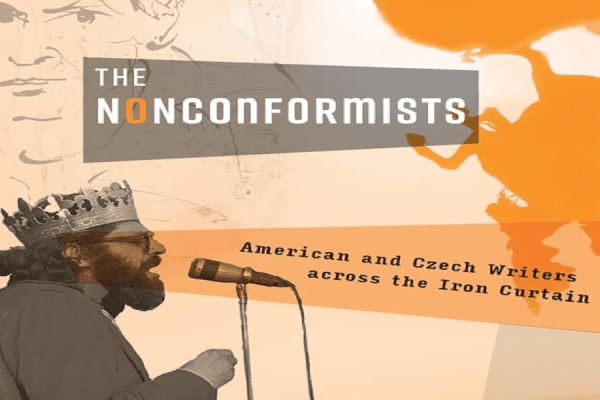
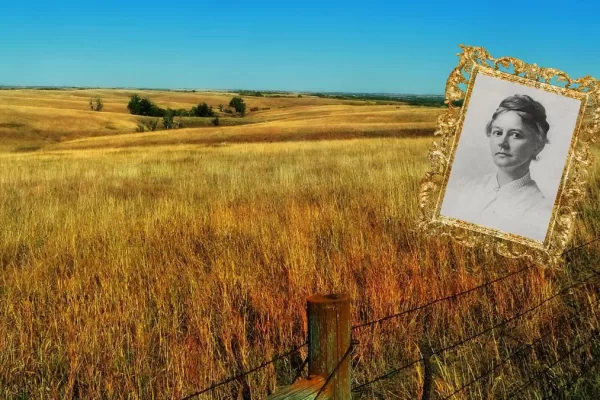
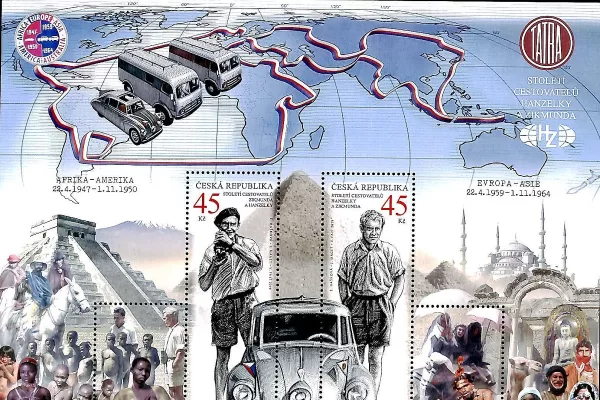















Excellent reading on a very interesting subject.
Well written true story. The detail in this story is amazing. This book kept me wanting to read the next chapter as if it was a fictional suspense story. Left you admiring the courage of the Americans, Germans and the horses. Thanks are due to the people concerned who reared, protected and saved these sensitive, intelligent horses.
If you liked Unbroken and War Horse, you will like this book. The writing and research in this book are excellent. I can’t imagine how the author found all the details she did about the characters and horses, who are long gone. The facts read like a story and the book is both interesting and extremely moving. However, keep in mind that it is a WWII book and some of the scenes are perfectly horrible. I would not recommend this book for kids or sensitive animal lovers. The descriptions of the horses dying of slaughter, exhaustion, injury, and starvation are gut-wrenching and I wasn’t even sure I could continue reading it at some points. The author follows the characters and the horses throughout their lives and at the end, I cried all the way through the last few chapters. That said, the whole tale is amazing and a testament to the horrors of war and the incredible courage and perseverance of these dedicated horse lovers. Have Kleenex nearby!
I found this story to be fascinating. I’ve read many WWII books, have seen many movies, and even spoken to my share of WWII vets. But I have never heard of this. The book starts out giving you a history of horse breeding within the US as well as Germany. It recounts the history of the use of horses in warfare particularly the US Cavalry. It’s the end of WWII and Germany realizes that they will lose the war. While they had been moving East at the beginning of the war, the Nazi’s decided to try to make the perfect war horse. They still believed that horses would be widely used. Whereas the Americans decided to go with engines. The Nazis had taken over stud farms and horse training schools for this breeding purpose. They were scattered throughout Czechoslovakia and Austria. As the Russians are pushing the Nazis back across their Eastern front the staffs at the stud farms feel terror for their horses. They know that if the Russians get ahold of the horses, they will either be killed or eaten. These horses were the creme de la creme of breeding stock, Arabians and Lippinzaner. The staff feels the only way to keep these horses safe was to surrender to the Americans. And that’s where the story takes off. Even though the title of the book gives away the story, it is still a suspenseful story. It is a story about the love of horses. It’s a story about how in the midst of mass murder and hunger and deprivation men on opposing sides can come together for the greater good.
I read this interesting book a few years ago and it was marvelous reading.
As I recall, it had pages and pages of footnotes which I appreciated.
I did not know about this history. I’m glad now I do.
I am glad I learned about these horses and the history of the American and Nazis working together to save these majestic animals. Your blog always fills my mind with new things. Keep up the good work.
Nice history lesson. Thanks.
Thanks for this piece of writing and history. These are beautiful horses and I saw the Lipizzans in Sarasota a few years ago at Herrmanns’ Royal Lipizzan Stallions in Myakka City. They are incredible animals.
I am so happy I pay a visit to this blog on regular basis. I appreciate all of your unique and interesting information.
I wasn’t aware of this history or of the Czech Kladruber horses. Now I know something new that I can share with my equine loving friends.
Very interesting post.